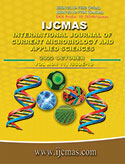


 National Academy of Agricultural Sciences (NAAS)
National Academy of Agricultural Sciences (NAAS)

|
PRINT ISSN : 2319-7692
Online ISSN : 2319-7706 Issues : 12 per year Publisher : Excellent Publishers Email : editorijcmas@gmail.com / submit@ijcmas.com Editor-in-chief: Dr.M.Prakash Index Copernicus ICV 2018: 95.39 NAAS RATING 2020: 5.38 |
Biofilm-producing staphylococci have been identified from various clinical samples such as pus, blood, urine and skin surfaces, in addition to device associated illnesses. In the study included 100 clinical isolates of Staphylococci spp. Biofilm detection was performed on clinical staphylococci spp. isolates using two different phenotypic methods, including Tissue Culture plate (TCP) and Congo red agar (CRA).By the TCP method revealed that, 55 (55%) Staphylococcus isolates were biofilm producers, while 45 (45%) were non- or weak biofilm producers. Among 55(55%) biofilm producers, 31 (56.36%) were strong biofilm producers, while 24 (43.63%) were moderate biofilm producers. By the CRA method, among 100 staphylococcal isolates, 10(10%) were produced biofilm while 90 (90%) were non/weak biofilm producers. Among the 10 biofilm producers, strong biofilm was produced by 3(30%) and moderate biofilm was produced by 7 (70%). TCP is considered a highly significant test, p = 0.001. As for CRA, it detected a very low number of biofilm producers compared to total positive biofilm producers. According to the p = 0.381, CRA method is considered the non-significant test.The two phenotypic methods were evaluated and it was found that CRA method was less sensitive in detecting biofilm formation. TCP can be recommended as a general screening method for detection of biofilm producing bacteria.
 |
 |
 |
 |
 |